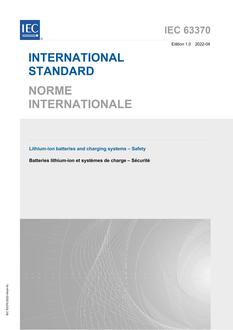
This document applies to the safety of lithium-ion batteries and charging systems for use in rechargeable battery-powered motor-operated or magnetically driven
– hand-held tools (IEC 62841-2),
– transportable tools (IEC 62841-3), and
– lawn and garden machinery (IEC 62841-4).
The above listed categories are hereinafter referred to as “products”.
NOTE 1 This document is structured in a way that other Technical Committees could reference this document in end product standards. For example, products outside of the scope of IEC 62841 (all parts) often use the same battery charging systems as in products covered by IEC 62841 (all parts).
The maximum nominal voltage assigned by the manufacturer for battery packs is 75 V DC.
Electric shock hazard is considered to exist only between parts of opposite polarity, except for cases where batteries are charged by a non-isolated charger.
Battery packs covered under this document intended to be charged by a non-isolated charger are evaluated by this document and to the requirements for protection against electric shock specified in IEC 62841-1:2014. When evaluating a battery pack for protection against electric shock, creepage distances, clearances and distances through insulation, the battery pack is fitted to the intended charger.
Since battery packs covered under this document are submitted to different use patterns (such as rough use, high charging and discharging currents), their safety can be evaluated only by this document or by IEC 62841-1:2014 and not by using other standards for battery packs, such as IEC 62133-2:2017, unless otherwise indicated in this document. All relevant aspects related to the safety of batteries are addressed in this document, such that the requirements of IEC 62133-2:2017 need not be separately applied.
For integral batteries, this document only applies to the integral battery when in combination with the product.
When evaluating the risk of fire associated with batteries, consideration has been given to the fact that these batteries are unattended energy sources and have been evaluated as such in this document. Requirements in other documents regarding the risk of fire due to the charging of these batteries are therefore considered to be fulfilled.
The following is considered within the context of these requirements.
– These requirements address the risk of fire or explosion of these batteries and not any possible hazards associated with toxicity nor potential hazards associated with transportation or disposal.
NOTE 2 IEC 62281:2019 covers the safety aspects of lithium-ion batteries during transport.
– Batteries and charging systems covered by these requirements are not intended to be serviced by the end user.
– This document is intended to provide an evaluation of the combination of a battery(ies) and its corresponding charging system(s).
– This document addresses the safety of lithium-ion batteries and charging systems during storage, use and charging. These requirements are only considered to be supplementary requirements in regards to battery charger fire and electric shock.
– This document refers to and requires parameters supplied in reference to the cells that establish conditions for safe use of those cells. Those parameters form the basis of acceptance criteria for a number of tests contained herein. This document does not independently evaluate the safety of cells. These parameters, taken as a set, constitute the “specified operating region” for a cell. There may be several sets of specified operating region(s).
This document is not intended to apply to general purpose batteries.
This document does not apply to the safety of battery chargers themselves. However, this document covers the safe functioning of lithium-ion batteries and charging systems.
For a battery(ies) intended to be charged by stand-alone battery chargers, the risks associated with a mains connection is addressed by the relevant battery charger standard. For products that incorporate power conversion circuitry for the purposes of providing an energy source for charging, the protection against the risks associated with a mains is addressed in the relevant product standard.
NOTE 3 IEC 60335-2-29:2016 and IEC 60335-2-29:2016/AMD1:2019 cover a variety of stand-alone chargers.
This document does not include safety requirements for the battery when incorporated into the product with respect to heating and mechanical strength. It is possible additional testing needs to be conducted in accordance with the relevant end product standard.
Product Details
- Edition:
- 1.0
- Published:
- 04/01/2022
- ISBN(s):
- 9782832211045
- Number of Pages:
- 80
- File Size:
- 1 file , 1.4 MB
- Note:
- This product is unavailable in Ukraine, Russia, Belarus